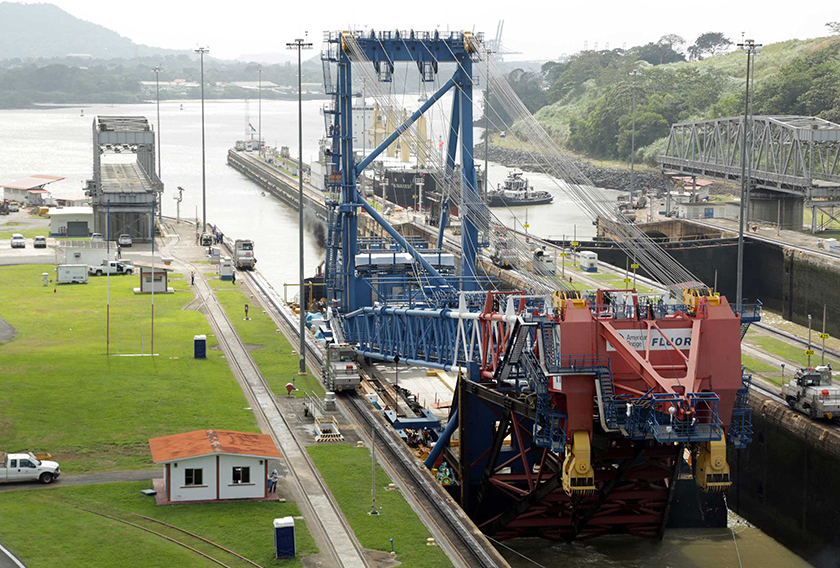Officially opened in 1914, the 48-mi. long Panama Canal connecting the Atlantic and Pacific Oceans via the Caribbean Sea by cutting through the Isthmus of Panama has greatly reduced travel time for ships. Considered one of the largest and most difficult engineering projects ever undertaken, the 100-year-old shortcut also provides safer passage by allowing ships to avoid the hazardous Cape Horn route around the southernmost tip of South America.
Each year, approximately 14,000 cargo and cruise ships pass through the Panama Canal, but recently, one unusual shipment passed through the historic locks.
The “Left Coast Lifter,” the world’s largest floating crane, passed through the Central American canal in January, on its way from its home near San Francisco to the Hudson River in New York, where it will be used to dismantle the deteriorating Tappan Zee Bridge and construct a replacement.
Guided by a crew of mariners, the floating crane traveled down the coast of California, Mexico and Central America, about 50 mi. (80 km) from the shore.
On Jan. 15, the crane reached the Panama Canal, where it was lifted 54 ft. (16.4 m) above Pacific sea level in two stages in the Miraflores Locks. According to the New York Times, the Lifter was pulled by the tugboat Lauren Foss and the Canal’s locomotive “mules.” Because the barge is only 10 ft. (3 m) narrower than the 110-ft. (33.5 m) locks, it took a half-hour for a Panama Canal Authority pilot to navigate each lock — three times the typical amount of time. (The Canal’s third, wider lane of locks is currently under construction and won’t be open until 2015.) To protect the crane during transit, “rub rails” were installed along the side to prevent contact with the lock walls.
“After sailing through the main channel of the 48-mi. (77 km) canal and being dropped about 85 ft. (26 m) at the Gatun Locks on the Atlantic side, the engineless barge crane, chaperoned by two tugboats, headed north across the Gulf of Mexico and started up the East Coast,” reported the New York Times.
Julian noted that a crew change took place at the Canal.
While some reports indicate that the toll for traversing the Canal was $70,000, Julian declined to confirm any specific amounts. Tappan Zee Constructors paid a transport company to handle all costs associated with the move.
Settling Into Temporary Quarters
After passing through the Panama Canal, the floating sheerleg crane crossed the Gulf of Mexico and made its way up the East Coast, through the New York Harbor to the Hudson River within the six- to eight-week schedule. It will remain docked in the Port of New York & New Jersey until it’s taken to the site of the New NY Bridge project in the spring.
“We don’t need it until spring,” Julian said, “but we wanted to have it on site in order to be ready when it’s needed.” She said weather, safety and protection of the crane were factors in the timing of its trip to New York.
After undergoing a “birthing process” at a private facility in the spring, the Left Coast Lifter will remain on site for the full duration of the Tappan Zee Bridge project.
“It will be used to set large units — decking for the two new spans — and removing the old bridge,” Julian said, noting that the Tappan Zee Bridge that will be demolished was originally built by American Bridge, which is one of the partners participating in the new bridge project.
Once it gets to work, the barge will be stabilized during large lifts by three removable barge stability floats that are attached to each side of the barge. According to Structure magazine, the float design criteria required that the floats be easy to install and remove on the water; therefore, a guidance system was designed to help align the floats with the barge. Once the floats are guided into the lower connection, the float is attached to the barge deck at the upper connection, using two 2.95-in. (7.5 cm) diameter pins.
After the project is completed in 2018, Julian said American Bridge and Fluor will decide what to do with the special crane next.
